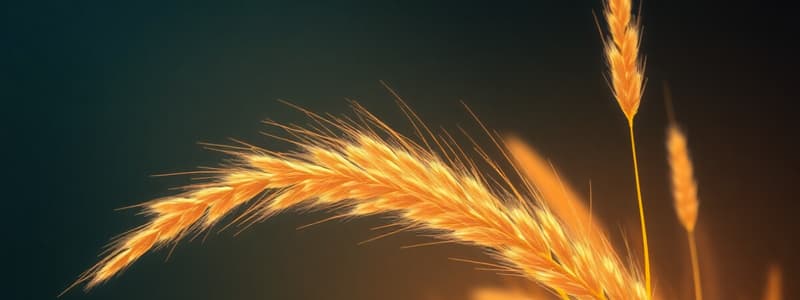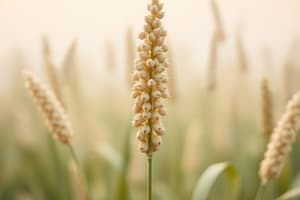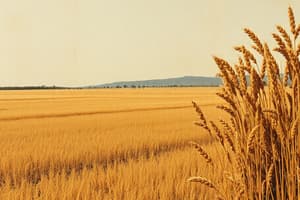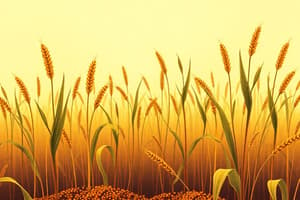Podcast
Questions and Answers
What family does the plant Eragrostis tef belong to?
What family does the plant Eragrostis tef belong to?
- Brassicaceae
- Poaceae (correct)
- Fabaceae
- Asteraceae
Which of the following characteristics best describes Eragrostis tef?
Which of the following characteristics best describes Eragrostis tef?
- Deciduous woody shrub
- Biennial tree
- Perennial vining plant
- Annual herbaceous plant (correct)
Where was Eragrostis tef first domesticated?
Where was Eragrostis tef first domesticated?
- Egypt
- South Africa
- Ethiopia (correct)
- India
Which part of the Eragrostis tef plant is primarily used for human consumption?
Which part of the Eragrostis tef plant is primarily used for human consumption?
What type of climate is most suitable for the growth of Eragrostis tef?
What type of climate is most suitable for the growth of Eragrostis tef?
What was the main issue with common names in plant classification during the Age of Herbals?
What was the main issue with common names in plant classification during the Age of Herbals?
What is the primary distinguishing feature between monocots and eudicots?
What is the primary distinguishing feature between monocots and eudicots?
What was Theophrastus's contribution to plant classification?
What was Theophrastus's contribution to plant classification?
Which of the following describes the root system of monocots?
Which of the following describes the root system of monocots?
Which of the following statements is true regarding the binomial nomenclature system introduced by Carl Linnaeus?
Which of the following statements is true regarding the binomial nomenclature system introduced by Carl Linnaeus?
What was a characteristic of the polynomial nomenclature used before Linnaeus's binomial system?
What was a characteristic of the polynomial nomenclature used before Linnaeus's binomial system?
Which plant family includes cinnamon and avocados?
Which plant family includes cinnamon and avocados?
Which of these flower arrangements is typical of eudicots?
Which of these flower arrangements is typical of eudicots?
Which statement about the magnoliid group is correct?
Which statement about the magnoliid group is correct?
What was one reason for the development of a Latin-based system of nomenclature?
What was one reason for the development of a Latin-based system of nomenclature?
What is NOT a rule of the International Code of Botanical Nomenclature?
What is NOT a rule of the International Code of Botanical Nomenclature?
Which of the following features is NOT characteristic of monocots?
Which of the following features is NOT characteristic of monocots?
How did early classification systems differ from modern classification systems?
How did early classification systems differ from modern classification systems?
Which of these economic plants belongs to the Piperaceae family?
Which of these economic plants belongs to the Piperaceae family?
What is a significant feature of the Victoria Water Lily that aids in its survival?
What is a significant feature of the Victoria Water Lily that aids in its survival?
Which of the following statements about the evolutionary relationship of flowering plants is true?
Which of the following statements about the evolutionary relationship of flowering plants is true?
According to the theories of Engler and Hooker, what was proposed about the earliest evolved flowers?
According to the theories of Engler and Hooker, what was proposed about the earliest evolved flowers?
What is an example of a species that has adapted to survive in foggy conditions?
What is an example of a species that has adapted to survive in foggy conditions?
Which adaptive characteristic is common among baobab trees in Madagascar?
Which adaptive characteristic is common among baobab trees in Madagascar?
Which classification system emphasizes environmental variation and variability in traits?
Which classification system emphasizes environmental variation and variability in traits?
What does the term 'primitive characteristics' refer to in the context of flowering plant evolution?
What does the term 'primitive characteristics' refer to in the context of flowering plant evolution?
Azarella compacta is primarily found in which region?
Azarella compacta is primarily found in which region?
What does a short form of a generic name, like P.glauca, represent in a manuscript?
What does a short form of a generic name, like P.glauca, represent in a manuscript?
Why is the biological species concept difficult to apply in practice for plants?
Why is the biological species concept difficult to apply in practice for plants?
What is one major problem with using morphology to classify plant species?
What is one major problem with using morphology to classify plant species?
What does the presence of fertile hybrids suggest about the biological species concept in plants?
What does the presence of fertile hybrids suggest about the biological species concept in plants?
How does evolution impact plant morphology according to the content?
How does evolution impact plant morphology according to the content?
How does the plant Rafflesia attract pollinators?
How does the plant Rafflesia attract pollinators?
Which of the following is a characteristic of the plant Duckweed?
Which of the following is a characteristic of the plant Duckweed?
What phenomenon describes the asexual reproduction method used by some plants like dandelion?
What phenomenon describes the asexual reproduction method used by some plants like dandelion?
What was the percentage of cultivation in Central America around 7,000 years ago?
What was the percentage of cultivation in Central America around 7,000 years ago?
Which crop was NOT mentioned as a major agricultural product in Central America by 3,500 years ago?
Which crop was NOT mentioned as a major agricultural product in Central America by 3,500 years ago?
Which civilization in Central America is known for intensive irrigation agriculture?
Which civilization in Central America is known for intensive irrigation agriculture?
What significant agricultural practice was introduced around 2,500 years ago?
What significant agricultural practice was introduced around 2,500 years ago?
What did the archaeological evidence suggest about the development of agriculture in wetter areas of Central and South America?
What did the archaeological evidence suggest about the development of agriculture in wetter areas of Central and South America?
What was a key factor that encouraged human populations to transition from a nomadic lifestyle to agriculture?
What was a key factor that encouraged human populations to transition from a nomadic lifestyle to agriculture?
How did the domestication of plants impact human society?
How did the domestication of plants impact human society?
Which part of human activity changed significantly due to the advent of agriculture?
Which part of human activity changed significantly due to the advent of agriculture?
What led to the change in food supply reliability with the advent of agriculture?
What led to the change in food supply reliability with the advent of agriculture?
Which question is NOT commonly addressed by ethnobotanists and cultural anthropologists regarding agriculture?
Which question is NOT commonly addressed by ethnobotanists and cultural anthropologists regarding agriculture?
What was a primary factor that led to the development of agriculture in arid regions?
What was a primary factor that led to the development of agriculture in arid regions?
Which of the following theories focuses on the role of weeds in the transition to agriculture?
Which of the following theories focuses on the role of weeds in the transition to agriculture?
What did Carl Sauer hypothesize about human populations and agriculture?
What did Carl Sauer hypothesize about human populations and agriculture?
Which archeological site reveals early agricultural practices in Asia Minor?
Which archeological site reveals early agricultural practices in Asia Minor?
What type of crops dominated European agricultural practices as they transitioned from Asia Minor?
What type of crops dominated European agricultural practices as they transitioned from Asia Minor?
Why is the evidence of agricultural development limited in humid environments?
Why is the evidence of agricultural development limited in humid environments?
What type of environment is noted for the best preservation of archaeological materials?
What type of environment is noted for the best preservation of archaeological materials?
Around what time does evidence suggest agriculture was commonly practiced in the Americas?
Around what time does evidence suggest agriculture was commonly practiced in the Americas?
Which of the following is NOT identified as a principal center for the origin of agriculture?
Which of the following is NOT identified as a principal center for the origin of agriculture?
What type of agriculture is evident at the Yang-Chao site in Central China?
What type of agriculture is evident at the Yang-Chao site in Central China?
What crops began to emerge in the Sahara region around 6,000 years ago?
What crops began to emerge in the Sahara region around 6,000 years ago?
What is the significance of various archaeological theories regarding agricultural development?
What is the significance of various archaeological theories regarding agricultural development?
What characteristic is favored by the selection pressures in cereal crops leading to efficient harvesting?
What characteristic is favored by the selection pressures in cereal crops leading to efficient harvesting?
Which of the following traits results from the selection against clonal axillary shoots in wild grasses?
Which of the following traits results from the selection against clonal axillary shoots in wild grasses?
What consequence does the loss of germination inhibitors have for cultivated crops?
What consequence does the loss of germination inhibitors have for cultivated crops?
Why are seeds that shatter before harvest considered unfavorable in agriculture?
Why are seeds that shatter before harvest considered unfavorable in agriculture?
Which of these factors is NOT a selection pressure affecting the development of agricultural plants?
Which of these factors is NOT a selection pressure affecting the development of agricultural plants?
What does a reduction in day-length sensitivity indicate for crop plants transported to northern climates?
What does a reduction in day-length sensitivity indicate for crop plants transported to northern climates?
Which of the following characteristics has NOT been selected for in the evolution of cereal crops?
Which of the following characteristics has NOT been selected for in the evolution of cereal crops?
What is the primary advantage of polyploidy in plants?
What is the primary advantage of polyploidy in plants?
What is the primary concern regarding genetically engineered (GE) crops?
What is the primary concern regarding genetically engineered (GE) crops?
Which of the following is a key factor in maintaining genetic diversity for crop development?
Which of the following is a key factor in maintaining genetic diversity for crop development?
Which statement correctly differentiates genetic modification from genetic engineering?
Which statement correctly differentiates genetic modification from genetic engineering?
Which of the following crops is commonly recognized as a genetically engineered variety?
Which of the following crops is commonly recognized as a genetically engineered variety?
What is mutability in the context of crop development?
What is mutability in the context of crop development?
What is a significant ecological concern associated with the loss of tropical rainforests?
What is a significant ecological concern associated with the loss of tropical rainforests?
Which natural event can induce polyploidy in plants?
Which natural event can induce polyploidy in plants?
How are Brussels sprouts relevant in the discussion of genetic mutations?
How are Brussels sprouts relevant in the discussion of genetic mutations?
What advantage do seedlings with higher food reserves have in high-density planting?
What advantage do seedlings with higher food reserves have in high-density planting?
What characteristic can weedy species develop to compete with crops?
What characteristic can weedy species develop to compete with crops?
Which crop was introduced to Europe from the Americas during the 1600s?
Which crop was introduced to Europe from the Americas during the 1600s?
What was one significant consequence of the Green Revolution?
What was one significant consequence of the Green Revolution?
What is a consequence of planting monocultures in agriculture?
What is a consequence of planting monocultures in agriculture?
Which best describes the process of genetic crossing in plant breeding?
Which best describes the process of genetic crossing in plant breeding?
What is a notable example of a crop that resulted from the crossing of wheat and rye?
What is a notable example of a crop that resulted from the crossing of wheat and rye?
Which characteristic of high-yield crops is often disadvantageous for farmers?
Which characteristic of high-yield crops is often disadvantageous for farmers?
What problem did the Irish potato famine illustrate regarding monoculture farming?
What problem did the Irish potato famine illustrate regarding monoculture farming?
Which of the following plants is native to Africa?
Which of the following plants is native to Africa?
What was a significant introduction to Europe during the Arabic colonization of Spain?
What was a significant introduction to Europe during the Arabic colonization of Spain?
What is one challenge faced by developing nations regarding the Green Revolution?
What is one challenge faced by developing nations regarding the Green Revolution?
Study Notes
Botanical Information
- Belongs to the Poaceae (grass) family.
- Type:
- Herbaceous plant.
- Considered an annual.
- Native distribution primarily in the Horn of Africa, particularly Ethiopia and Eritrea.
History as a Food Plant
- First domesticated in Ethiopia around 4000-1000 BCE.
- Most widely grown in Ethiopia, where it is a staple food crop.
Utilization
- The edible part of the plant is the seed.
- Seeds are ground into flour, which is commonly used to make traditional dishes like injera, a fermented flatbread.
- Harvested by cutting the plants at maturity, followed by threshing to separate seeds from chaff.
- Seeds can also be processed into porridge or brewed as a beverage.
History of Plant Classification
- Plant classification has roots in Ancient Greek times, aimed at developing a natural grouping system.
- Key classification questions include the criteria for grouping organisms and the definition of similarity.
- Early classification systems were artificial, focused on plant appearance and medicinal properties, not evolutionary relationships.
- Theophrastus, a student of Aristotle, established the first plant classification system around 2300 years ago, recognizing families like Pea and Sunflower.
- The Age of Herbals (1470-1670) expanded plant knowledge through herbal manuscripts that illustrated plants and their medicinal uses, creating issues with inconsistent common names.
- A standardized Latin-based nomenclature emerged to resolve confusion around common names.
- Carl Linnaeus simplified plant naming with the binomial system, introduced in Species Plantarum (1753), comprising a generic name and species epithet (e.g., Picea glauca).
- The binomial nomenclature is governed by the International Code of Botanical Nomenclature, including rules on capitalization, italicization, and authority designations.
Plant Species
- Classification is centered on the species concept, defining a biological species as a group able to interbreed but not with others, producing sterile offspring.
- Applying this definition presents challenges in plants due to spatial separation, hybrid fertility, and asexual reproduction in certain species, like the dandelion (agamospermy).
- Morphological classification (studying form, structure, and size) is commonly employed, though environmental factors influence plant morphology and may complicate classification.
- Morphological plasticity means that plants' forms can change drastically based on environmental conditions; for example, potentilla is light-sensitive.
Evolutionary Relationships of Flowering Plants
- Morphologically-based classifications (phenetic systems) use conservative characters while avoiding highly variable traits.
- The publication of Charles Darwin's Origin of Species (1859) sparked interest in phylogenetic classification emphasizing evolutionary relationships.
- Classification depends on understanding ancestral relationships and defining primitive versus advanced plant features, complicated by poor fossil records.
- Two historical theories on flowering plant evolution proposed by Engler and Hooker differ in the complexity and characteristics of early flowers.
- The modern consensus aligns with Hooker’s modified view, recognizing 300 to 350 flowering plant families, corroborated by molecular biology advancements.
Flowering Plants: Monocots and Eudicots
- Angiosperms are traditionally divided into monocots (one cotyledon) and eudicots (two cotyledons).
- Monocots display herbaceous forms, floral parts in threes, linear leaves with parallel veins, and short-lived primary roots.
- Eudicots exhibit broad leaves with net veins, floral parts in fours or fives, and often have persistent primary roots forming a taproot.
- Recent genetic studies reveal the division into monocots and eudicots is simplistic; a third group, magnoliid Angiosperms, predates their divergence.
- Economically significant magnoliid families include:
- Magnoliaceae: horticultural and timber species.
- Lauraceae: spices like cinnamon and avocado.
- Annonaceae: tropical fruits, including soursop and custard apple.
- Piperaceae: black pepper.
- Myristicaceae: nutmeg and timber species.
Domestication of Plants
- Occurred approximately 10,000 years ago, transitioning from hunter-gatherer societies to settled agricultural communities.
- Hunter-gatherers had limited population due to seasonal food supplies, necessitating a nomadic lifestyle.
- Early humans were omnivores and crucially relied on plants for food, medicine, and psychoactive substances.
- Modern-day hunter-gatherer societies, like the !Kung of central Africa, spend two days per week acquiring food, allowing for leisure time.
Shift to Agriculture
- Settling in one place offered advantages: reliable food supply, access to trade routes, and consistent water sources.
- This shift led to cultivation of plants, domestication of animals, and permanent settlements.
- Resulted in increased food reliability, larger populations, greater environmental control, and specialization in roles.
Origins of Agriculture
- Defined as tilling land for the deliberate planting of crops; provides year-round food supply.
- Independent development of agriculture occurred in Asia Minor, China-Southeast Asia, and the Americas between 5,000-7,000 years ago.
- Earliest agricultural indications found in arid regions such as the Fertile Crescent (modern Iraq, Iran, and Turkey).
Theories of Domestication Transition
- Childe's Theory: Humans and herd animals congregated near watering holes, which led to soil disturbance and favoring of "weedy" grass species, initiating the Neolithic Revolution.
- Sauer's Hypothesis: Sedentary living emerged in favorable climates, with less optimal areas being settled as populations grew, compelling plant domestication.
- Anderson's Theory: Highlights the role of weeds in creating genetic variation in disturbed habitats, leading to domesticated plants.
- Binford and Flannery's Hypothesis: Early gatherers became skilled botanists, leading to gradual cultivation necessity driven by population pressures.
Centers of Agricultural Origin
- Asia Minor (Near East): Evidence from Jarmo indicates the cultivation of wheat and barley, along with domestication of goats, sheep, and various crops; urban civilization developed in Tigris-Euphrates valleys around 6,000 years ago.
- Central China (Far East): Agriculture evidence from the Yang-Chao site shows developed rice agriculture and complex societies dating back roughly 6,000 years.
- Central America: Agriculture emerged slower in Central America compared to Asia Minor, with key developments like the domestication of maize and other crops appearing around 7,500 years ago.
Agricultural Developments in Central America
- Transition from hunter-gatherer lifestyles to agricultural practices was gradual, with a mix of cultivation and wild harvesting.
- By 3,500 years ago, significant agricultural practices included the domestication of various crops like corn, tomatoes, and squash.
- Advanced agricultural practices by 2,500 years ago showcased irrigation systems and selective crop cultivation by Aztec, Mayan, and Inca civilizations.
Selection Pressures on Plants
- Plant characteristics evolve through the cumulative effects of the genome and natural selection.
- Cultivation of wild plants leads to significant modification of their phenotypic traits.
- Passive selection occurs when the link between planting and harvesting promotes beneficial cultivars, even without deliberate selection.
- Wild plants produce many seeds that mature over time, leading to some seeds surviving unfavorable conditions.
- Genotype 1: Seeds mature slowly, few at once; Genotype 2: Seeds mature simultaneously, resulting in higher harvest efficiency.
- Characteristics favored in cereal crops include:
- Uniform seed maturation for consistent harvest.
- Compression of tillering to encourage synchronous seed maturity.
- Loss of seed appendages to prevent shattering before harvest.
- Simultaneous germination by removing chemical inhibitors.
- Increase in number of florets for more seed production.
- Reduction of day-length sensitivity for adaptability to varied climates.
- Loss of shattering to retain seeds on the plant until harvest.
- Increased starch reserves in seeds to enhance seedling competition and growth.
- Weedy species adapt by synchronizing seed maturity with crop plants, complicating harvesting.
Geographic Origin and Spread of Plants
- Many common food plants had restricted original distributions; introductions transformed agriculture and diets.
- Notable introductions include:
- Potatoes from South America to Europe.
- Tomatoes and chili peppers from South America to other regions.
- Romans brought Mediterranean species to Northern Europe, while Arabic colonization introduced rice and citrus.
- European colonization significantly reshaped crop distributions, such as corn and potatoes spreading across Europe.
- Asia boasts many indigenous crops, particularly rice; significant American introductions include corn and chili pepper.
- Africa's indigenous food plants include coffee and millet, with important introductions from Asia and the Americas.
- The Americas are rich in native crops such as maize and potatoes, with few crops originating in North America.
The Green Revolution
- Focus on high-yield crops has led to trade-offs in disease and pest resistance.
- These crops generally require intensive resources: fertilizers, water, and pesticides.
- The Green Revolution often benefits wealthy nations and large-scale farms while disadvantaging developing regions.
- Monocultures increase vulnerability to pests and diseases, exemplified by the Irish potato famine due to reliance on a single crop variety.
- The cycle of breeding for yield often results in pests adapting and necessitating new resistant cultivars.
Plant Breeding: Genetic Modification
- Plant breeding methods include genetic crossing, back-crossing, artificial doubling of chromosome numbers, and genetic mutation.
- Genetic crossing maintains hybrid vigor in crops, with cloning methods like grafting and tissue culture facilitating propagation.
- Triticale, a hybrid of wheat and rye, offers higher resilience and yields, developed in the 1960s.
- Colchicine is used to induce polyploidy in plants, resulting in increased size and robustness—prevalent in many modern crops.
- Genetic mutations can promote beneficial traits; Brussels sprouts are a notable example of a successful spontaneous mutation.
- Genetic engineering introduces genetic information from other organisms to enhance crop traits; common crops include genetically engineered canola and corn.
- Strong consumer resistance to GE crops in Europe has led to regulatory challenges, and concerns persist about ecological impacts and accessibility for farmers in developing nations.
Genetic Diversity
- A diverse genetic pool is crucial for developing new crop varieties and medications.
- Loss of older plant varieties limits available genetic resources beneficial for breeding programs.
- Geneticists are seeking old cultivars, such as apples, to inform new variety development.
- Tropical rainforests house a significant portion of Earth's species and genetic resources, with many plants yet to be discovered that could offer essential food or medicinal benefits.
Studying That Suits You
Use AI to generate personalized quizzes and flashcards to suit your learning preferences.
Description
This quiz explores the botanical classification, history, and utilization of Teff, a vital food plant. Participants will answer questions regarding its family, types, native distribution, and processing methods. Dive deep into the significance of this important crop and its role in agriculture.




